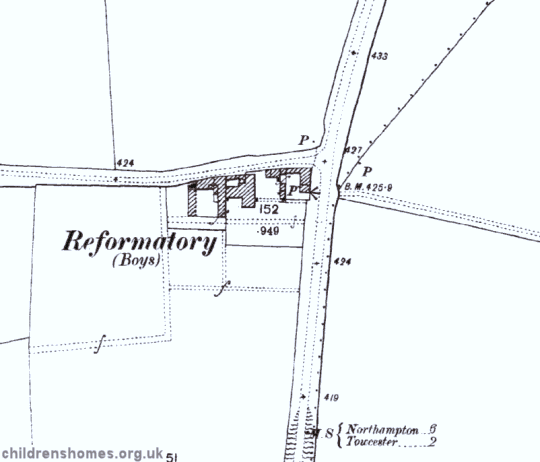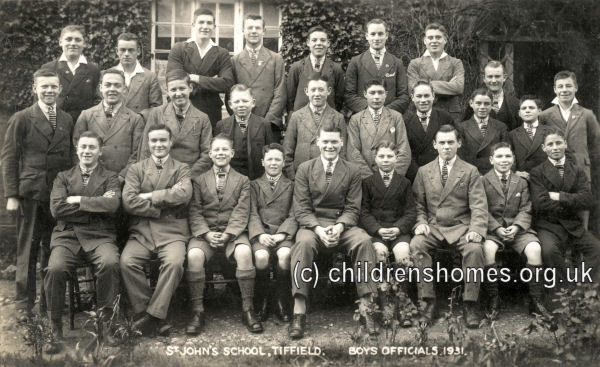Northamptonshire Society's Reformatory School for Boys, Tiffield, near Towcester, Northamptonshire
The Northamptonshire (or Northampton) Society was originally founded in 1812, but re-organized in 1854, with the Rev. H.J. Barton and Lord Alwyne Compton as two of its leading members. The Society's main object was the improvement of education in the county, including the establishment of an institution for young offenders. On January 21, 1856, the Society's Reformatory School for Boys was opened in premises on what is now St John's Road, Tiffield, near Towcester. It could accommodate up to 30 boys aged from 13 to 15 at their date of admission.
A report on the School in 1857 described it as follows:
The School's master and matron at this date were Mr and Mrs Berin. In 1860, Mr Berin resigned his post due to the long illness of his wife. A new an inexperienced master was then appointed who proved not to be up to the job. An inspection report in 1862 found that the dormitory and school-room were wanting in order and cleanliness, and the boys very rough and careless, and unsatisfactory in their school work. Superintendence of the School was then given to Mr Goode, a former assistant master at the Bradwall Reformatory and master at the Glamorgan Reformatory. Mr Goode remained in charge until his death in 1879, following which Mr and Mrs Slack were appointed as superintendent and matron.
By 1880, following additions to the building, the School could accommodate up to 50 boys. The industrial training was chiefly working the School's garden and 45 acres of farmland, with a few of the boys making and mending their own clothes.
The School site is shown on the 1900 map below.

Northampton Society's Reformatory School for Boys site, Towcester, c.1900.
In 1900, William McColl and his wife Alice were appointed as superintendent and matron, taking over from the previous incumbents, Mr and Mrs Jones. It was the start of a long family connection with the School. The McColls's son, Trevor Lancelot McColl, took over as superintendent of the School in 1922, a post he held until his death in 1946.
In the early 1900s, a number of improvements and extension were made to the premises. In 1903, eight new pigsties were built. In 1908-9, the buildings were extended with the addition of new workshops, office, committee room, laundry, wash-house and store-room. Physical drill was a regular part of the boys' routine and part of the dining-room was fitted up as a gymnasium, where air rifle shooting was also practised. Football and cricket matches were played with other local teams, and fife and drum band was started. In 1908, the official capacity of the School was increased to 100 places. The industrial training now included shoemaking, tailoring and technical drawing.
In around 1925, the institution was renamed St John's School.

St John's School "Boys' Officials", Tiffield, 1931. © Peter Higginbotham
In 1933, St John's became an Approved School, one of the new institutions introduced by the 1933 Children and Young Persons Act to replace the existing system of Reformatories and Industrial Schools. It accommodated up to 100 Intermediate Boys aged between their 13th and 15th birthdays at their time of admission. The industrial training at the School was now largely confined to gardening and carpentry.
In 1973, the St John's became a Community Home with Education (CHE) under the control of Northamptonshire County Council.
The original buildings no longer survive and the Gateway School now occupies site.
Records
Note: many repositories impose a closure period of up to 100 years for records identifying individuals. Before travelling a long distance, always check that the records you want to consult will be available.
- Northamptonshire Record Office, Wootton Hall Park, Northampton, Northants, NN4 8BQ. Holdings: Minute books (1854-1973, with gaps); Log books (1876-1982, with gaps); Admission registers (1872-90, 1908-36, 1972-80); Baptisms in chapel(1964-83).
Bibliography
- Carpenter, Mary Reformatory Schools, for the Children of the Perishing and Dangerous Classes, and for Juvenile Offenders (1851, General Books; various reprints available)
- Carlebach, Julius Caring for Children in Trouble (1970, Routledge & Kegan Paul)
- Higginbotham, Peter Children's Homes: A History of Institutional Care for Britain's Young (2017, Pen & Sword)
- Abel Smith, Doroth Crouchfield: A History of the Herts Training School 1857-1982 (2008, Able Publishing)
- Garnett, Emmeline Juvenile offenders in Victorian Lancashire: W J Garnnett and the Bleasdale Reformatory (2008, Regional Heritage Centre, Lancaster University)
- Hicks, J.D. The Yorkshire Catholic Reformatory, Market Weighton (1996, East Yorkshire Local History Society)
- Slocombe, Ivor Wiltshire Reformatory for Boys, Warminster, 1856-1924 (2005, Hobnob Press)
- Duckworth, J.S. The Hardwicke Reformatory School, Gloucestershire (in Transactions of the Bristol and Gloucestershire Archaeological Society, 1995, Vol. 113, 151-165)
- Higginbotham, Peter Children's Homes: A History of Institutional Care for Britain's Young (2017, Pen & Sword)
- Hyland,Jim Yesterday's Answers: Yesterday's Answers: Development and Decline of Schools for Young Offenders (1993, Whiting and Birch)
- Millham, S, Bullock, R, and Cherrett, P After Grace — Teeth: a comparative study of the residential experience of boys in Approved Schools (1975, Chaucer Publishing)
Links
- Red Lodge Museum, Bristol — a former girls' reformatory.
Except where indicated, this page () © Peter Higginbotham. Contents may not be reproduced without permission.


